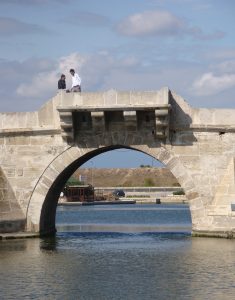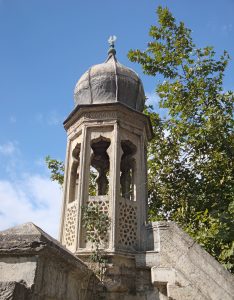İstanbul’s “Big Bridge” suburb
 Old names: Athyra (Roman), Kalikratia
Old names: Athyra (Roman), Kalikratia
Sometimes it turns out that there’s a treat lying in wait to be discovered right on your doorstep, especially if you live in İstanbul. That great urban sprawl to the west of the city, for example, might not seem very promising territory for sightseeing, but then you probably haven’t been to Büyükçekmece, the suburb that feels almost like a small town set on the banks of the Büyükçekmece Gölü, a large lagoon connected to the Sea of Marmara.
In archaic Turkish usage, “çekmece” meant bridge, so the suburb’s name means “big bridge”. The reason for this becomes abundantly plain as soon as you arrive at the lagoon. For it was here in 1566-67 that the great Ottoman architect Sinan built a bridge made up of four connecting parts at the place where a few years earlier his patron Sultan Süleyman the Magnificent is believed to have had a lucky escape when he scrambled onto a nearby roof to escape a flash flood. The bridge is a thing of extraordinary grace and beauty whose four separate sections are of unequal length but boast a total of 28 arches between them. Sinan himself was in no doubt about its importance: “This is the masterpiece among my buildings,” he is said to have remarked.
Extending for 636 metres, the four-in-one bridge is perfect for a short stroll. To walk across its four slightly humpbacked sections is a rollercoaster of an experience; although they were restored recently they still retain some of their original cobbling — picturesque if not especially easy to walk on.
Heading out from Büyükçekmece the vista is of a distant cement works. At the far end of the bridge, though, a huge stone slab commemorates its building by Sinan. As you walk back again you will have in front of you the striking sight of the 235m-tall Endem TV Tower at Beylikdüzü, until recently the tallest tower in Turkey.
What makes a trip out here particularly worthwhile is that you arrive to find that it was not the only mark that Sinan left on the area. Immediately facing the bridge across a newly landscaped park is a long, low stone building called the Kurşunlu (Leaded) Han because its roof was originally covered with lead. This was designed by Sinan to accommodate traders heading for İstanbul from Europe, and was the last in a chain of caravanserais where they could be sure of three nights’ free bed and board before reaching the Ottoman capital.
Restored in the 1980s, it now serves as the venue for occasional cultural events. Lined up in front of it are a few remnants of what was once the Roman settlement of Athyra, known to history as the site where in 447 the Emperor Theodosius II signed a peace treaty with Atilla the Hun who had been put off a plan to attack what was then the Byzantine capital Constantinople by the emperor’s new and hastily completed city walls.
Not far from the caravanserai stands the fine Kanuni Sultan Süleyman Çeşmesi, a tripartite fountain dating back to 1566, another work of Sinan that is still in use today.
But the finest of Sinan’s lesser-known gifts to Büyükçekmece is the small Sokollu Mehmed Paşa Cami just around the corner from the caravanserai which was built in 1567 for the eponymous grand vizier (the man for whom Sinan also built the more famous and readily accessible mosque in İstanbul’s Kadırga district). The much rebuilt body of the mosque is nothing to write home about but its crowning glory is the exquisite stone minaret that sits beside the entrance gate. It was carved from a single piece of stone, a feature it supposedly shares with only one other mosque in Cairo in Egypt.
Given the quantity of historic buildings clustered so close together it’s good to be able to report that the whole area has been tidied up and adorned with a set of statues of Turkish greats as variable as Sultan Süleyman the Magnificent, the bard Aşık Veysel (1894-1973), the medieval poet Yunus Emre, the puppets Karagöz and Hacıvat, and Yörük Ali Efe (1895-1951), a hero of the Turkish War of Independence.
The park is also ringed with small restaurants, each of them featuring the cuisine of a different part of the country. If you want to eat here, however, you could also try one of the two large fish restaurants on the side of the bridge closest to the main road. These overlook the colourful harbour where fishing boats still tie up and whence fishermen set sail every night to trawl for lüfer (bluefish) in the Sea of Marmara.
If you take the road from behind the Kurşunlu Han you can walk into Büyükçekmece proper, passing a wooden house in the grounds of the local school which was once home to Enver Paşa, one of the Young Turks who struggled to modernise the Ottoman Empire. Restored in 2007, it now serves as a children’s cultural centre.
In the heart of the shopping centre you will see the remains of an old hamam (Turkish bath) protected by a concrete shelter. Otherwise, Büyükçekmece is just another identikit suburb, clinging nostalgically to memories of a rural past now reduced to a prominent statue of a milkmaid leading her cow.
Returning to the centre of İstanbul you will probably pass through Haramidere (Brigands’ Valley) which boasts another elegant Ottoman stone bridge, albeit completely hemmed in by development, before coming to the Küçükçekmece Lagoon.
Transport info
By far the easiest way to visit Büyükçekmece is by private car. Failing that you can get there from İstanbul city centre by public transport but only with several changes.
Either take the tram to Zeytinburnu, change to the Metro and get out at Yenibosna where you can pick up a minibus to Büyükçekmece; or take the tram to Cevizlibağ/A.Ö.Y and change to the Metrobus for Avcılar. There you can pick up a minibus on to Büyükçekmece although there are so many different bus stops by the road that your Turkish will need to be fairly robust to find the right one.

